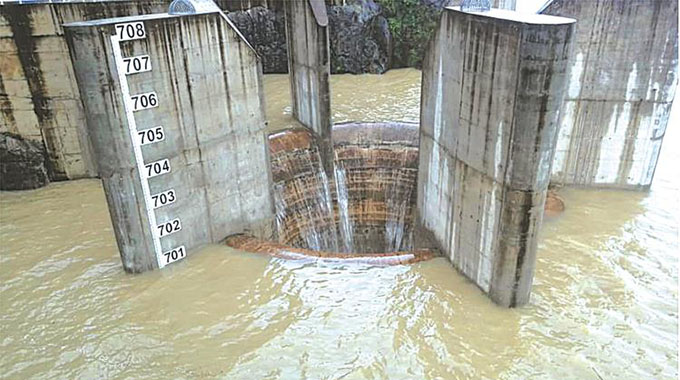
Ruth Butaumocho
African Agenda
The last two months have seen several countries in the Southern African region receiving lots of rains as a result of Cyclone Chalane and Cyclone Eloise.
However, the advent of the two cyclones have not been without casualties.
The tropical storms have resulted in death and destruction of property running into millions of dollars across the region.
Zimbabwe has borne the brunt of tropical storms, leaving a trail of destruction of properties, mainly in Manicaland and Masvingo.
While some of the cases could have been avoided after the southern region early warning system unit alerts to different countries, others were simply unavoidable as torrential rains and gusty winds ferociously swept across the region, overwhelming manpower and resources that had been set aside to ameliorate the adverse weather effects.
In the midst of the losses, several countries in the region still have something to smile about, after heavy rains that pounded the region, filled their inland water sources, in a development that could end perennial water woes the region has been battling over the years.
Multitudes of urban dwellers are revelling in the rains because the downpour signalled an end to their water woes that had haunted them for months.
Unlike previous years, last year’s water woes were dire, resulting in thousands of people failing to access clean water.
With no other alternative water sources, major cities such as Harare and Bulawayo had to ration the precious liquid. Still that did not end the perennial water woes.
For satellite cities like Chitungwiza, the problem was so severe that residents resorted to buying water for daily use from “waterprenuers”, whose prices were beyond the reach of many.
On a national scale, Zimbabwe finds itself in a comfortable position following the rains because it now has adequate water bodies that can be used to harness water for use and irrigation in nearly all the provinces across the country.
During the weekend, the nation witnessed the spectacle spilling of Tugwi-Mukosi Dam in Southern Masvingo, the largest interior water body in Zimbabwe, with a 1,8 billion cubic capacity reservoir.
Already optimism is high that the lake which spilled for the first time since its completion in 2017 will boost irrigation as water harnessed in the lake can supply the Lowveld greenbelt for three years without replenishment.
With the water from the dams expected to irrigate over 40 000 hectare of land through improved irrigation technology for three seasons, farmers can start producing crops for export market, while keeping enough to enhance local food reserves.
Farmers should consider increasing their hectarage in major crops such as wheat, soya bean, sugar beans, winter maize and horticultural produces that have been on a decline in the last few years owing to water for irrigation among other challenges, such as shortage of electricity its pricing model.
Outsides Tugwi-Mukosi, the country also boasts several other water bodies mainly in Masvingo and Manicaland provinces, which have the same capacity to bolster irrigation activities in addition to providing adequate water for community and commercial use.
The recently commissioned Marovanyati Dam in Buhera is also a strategic water body that has capacity to irrigate more than 1 200 hectares throughout the year.
Neighbouring communities can now draw raw water for use and farming.
Such investments, if effectively used and coupled by adequate agricultural funding and the right attitude can bolster the country’s economy within a short period.
Looking into the future, the Government should consider utilising these inland water bodies for electricity generation to ameliorate the country’s deficit, which currently stand at 600 megawatts to meet the national demand of 1 800 megawatts.
While the water bodies put Zimbabwe on a safe pedestal, thanks to the Second Republic initiative, the nation cannot sit on its laurels, but should continue to invest in similar water harvesting projects to avert serious water challenges the nation has been facing.
The changing climatic conditions and population growth, calls for constant investment in water-related projects, a situation not unique to Zimbabwe alone, but a continental one.
Population growth in the last decade and the effects of climate change have presented serious challenges for several African countries.
As Africa’s cities grow, demand for water has become a source of consternation.
Not only are water and sanitation services essential for city residents, they are also indispensable for the tourism sector, which is an important source of government revenue, employment and economic growth.
Researchers have since predicted that in the coming decade, the water crisis remains the highest concern ahead of climate change, extreme weather events, food crises and social instability.
A director at one of the global water campaigns — Helena Molina-Valdes of UNISDR’s “Making Cities Resilient” Campaign — aptly described the situation when she said; “Many cities and towns throughout Africa are struggling to meet basic urban infrastructural needs such as clean water, waste management disposal and drainage systems”.
Investing in inland water bodies such as rehabilitation of water infrastructure and the construction of dams becomes the immediate solution for Zimbabwe and other African countries.
Because of the capital intensiveness of the projects, the Government will also need to consider private partnership to expedite the projects.
Currently South Africa is working with private partners to provide water for its citizens. The partnerships with financial institutions and other corporate organisations have already yielded positive results.
